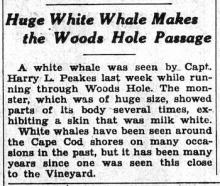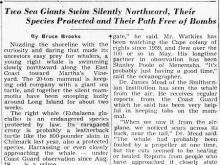Nuzzling the shoreline with the curiosity and daring that made its ancestors easy prey for whalers, a young right whale is swimming slowly northward along the East Coast toward Martha’s Vineyard. The 20-ton mammal is keeping odd company with a giant sea turtle, and together the silent mammoths have been snooping lazily around Long Island for about two weeks.
The right whale (Eubalaena glacialis) is an endangered species protected by law. Its carapaced crony is probably a leatherback turtle like the 800-pounder slain in Chilmark last year, also a protected species. Harassing or even closely approaching the whale - under Coast Guard observation since Aug. 18 - is a crime.
Experts at the Woods Hole Oceanographic Institution think the whale is a straggler from a herd that passes Cape Cod every spring on its way from Florida to Nova Scotia. Dr. Roger Payne of the New York Zoological Society said it is not unusual for juvenile whales to be swimming alone (the whale’s age is estimated by its length - this one reaches 35 feet, while adults attain a length of 65 feet).
Dr. Payne blames the solitude on a social structure within whale colonies, something like a maturity rite for adolescents, but William Watkins at Woods Hole thinks such behavioral analyses are a bit far-fetched.
“It’s probably just a young fellow who discovered a run of good food and stuck around to investigate,” he said. Mr. Watkins has been watching the Cape colony of rights since 1959, and flew over the 100 or so in May. His longtime partner in observation has been Stanley Poole of Menemsha. “It’s probably just having a good time,” said the oceanographer.
Dr. James Mead of the Smithsonian Institution has seen the whale from the air. He receives regular reports from the Coast Guard which he said has been very helpful in keeping tabs on the mammal.
“When we saw it from the airplane, we noticed scars across its back, near the tail,” Dr. Mead said. “The whale had probably been fouled by a propeller at one time, but the cuts seemed to be healing or healed. Reports from people who have approached it closely state that the animal is apparently not bothered by the injury.”
Right whales are notorious for venturing close to shore, Dr. Mead said, and this one seems to be no exception. In the 1600s eubalaena were killed in great quantities, a slaughter that continued until the latter 19th century. The whales could be easily lanced from open boats not far from shore, a process that made rights the favorite prey of coastal settlers whose towns had no maintained whaling industry. The last known kill of a right whale was in 1913, off Long Island.
Now the species is protected by the national endangered species act and the marine mammal protection act. But the population of right whales is still dangerously low, said Dr. Mead. Unlike the gray whale, which has made a spectacular comeback in California after approaching extinction due to whaling, the right whale seems to have problems with its population dynamics.
Mr. Watkins said he is hopeful that the species is keeping a steady productivity, however. The Florida herd has been passing the Cape since 1955, and has grown, he said. It may be soon that the population of right whales will be high enough for individuals to start breaking off and staying in certain areas, such as around Long Island, Cape Cod, or Martha’s Vineyard. This is hope, not prediction, he admits.
The whales’ approach to the Island has been signaled from time to time. Mr. Poole spotted eight of them off Menemsha in 1956. Last year this reporter found the lower jawbone of a young right whale on South Beach.
The Coast Guard will continue to follow the progress of the Long Island whale and, as long as the strange friendship lasts, the more common turtle. The only dangers facing the young mammal on its voyage north are men and their boats - until it approaches Noman’s Land, the practice bombing target three miles off Vineyard shores, on which the U. S. Navy dumps dummy bombs.
If the whale’s timing is right it may even slip by this aerial hazard. Cmdr. Richard Woodall, operations officer at the South Weymouth naval air station whence the practice runs fly, said the schedule for Navy use of Noman’s Land is sparse this month, including only six days. He added that the practice bombing was confined to the actual land mass, and that none of the cast aluminum dummies were dropped in the water.
However, Commander Woodall said the Navy would not utilize the target if there were reports that the whale was “within one mile or so” of Noman’s. The pilots of Navy planes will be on the lookout for it, he said, and any fishermen or yachtsmen who report a sighting of the whale to the Navy will be heard.










Comments